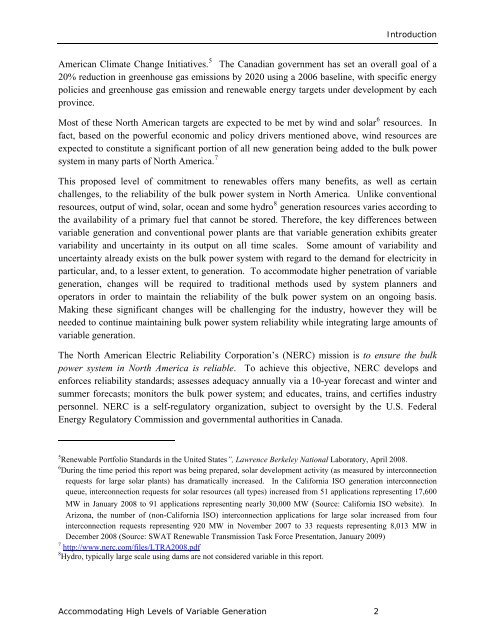Accommodating High Levels of Variable Generation - NERC
Accommodating High Levels of Variable Generation - NERC
Accommodating High Levels of Variable Generation - NERC
Create successful ePaper yourself
Turn your PDF publications into a flip-book with our unique Google optimized e-Paper software.
Introduction<br />
American Climate Change Initiatives. 5 The Canadian government has set an overall goal <strong>of</strong> a<br />
20% reduction in greenhouse gas emissions by 2020 using a 2006 baseline, with specific energy<br />
policies and greenhouse gas emission and renewable energy targets under development by each<br />
province.<br />
Most <strong>of</strong> these North American targets are expected to be met by wind and solar 6 resources. In<br />
fact, based on the powerful economic and policy drivers mentioned above, wind resources are<br />
expected to constitute a significant portion <strong>of</strong> all new generation being added to the bulk power<br />
system in many parts <strong>of</strong> North America. 7<br />
This proposed level <strong>of</strong> commitment to renewables <strong>of</strong>fers many benefits, as well as certain<br />
challenges, to the reliability <strong>of</strong> the bulk power system in North America. Unlike conventional<br />
resources, output <strong>of</strong> wind, solar, ocean and some hydro 8 generation resources varies according to<br />
the availability <strong>of</strong> a primary fuel that cannot be stored. Therefore, the key differences between<br />
variable generation and conventional power plants are that variable generation exhibits greater<br />
variability and uncertainty in its output on all time scales. Some amount <strong>of</strong> variability and<br />
uncertainty already exists on the bulk power system with regard to the demand for electricity in<br />
particular, and, to a lesser extent, to generation. To accommodate higher penetration <strong>of</strong> variable<br />
generation, changes will be required to traditional methods used by system planners and<br />
operators in order to maintain the reliability <strong>of</strong> the bulk power system on an ongoing basis.<br />
Making these significant changes will be challenging for the industry, however they will be<br />
needed to continue maintaining bulk power system reliability while integrating large amounts <strong>of</strong><br />
variable generation.<br />
The North American Electric Reliability Corporation’s (<strong>NERC</strong>) mission is to ensure the bulk<br />
power system in North America is reliable. To achieve this objective, <strong>NERC</strong> develops and<br />
enforces reliability standards; assesses adequacy annually via a 10-year forecast and winter and<br />
summer forecasts; monitors the bulk power system; and educates, trains, and certifies industry<br />
personnel. <strong>NERC</strong> is a self-regulatory organization, subject to oversight by the U.S. Federal<br />
Energy Regulatory Commission and governmental authorities in Canada.<br />
5 Renewable Portfolio Standards in the United States”, Lawrence Berkeley National Laboratory, April 2008.<br />
6 During the time period this report was being prepared, solar development activity (as measured by interconnection<br />
requests for large solar plants) has dramatically increased. In the California ISO generation interconnection<br />
queue, interconnection requests for solar resources (all types) increased from 51 applications representing 17,600<br />
MW in January 2008 to 91 applications representing nearly 30,000 MW (Source: California ISO website). In<br />
Arizona, the number <strong>of</strong> (non-California ISO) interconnection applications for large solar increased from four<br />
interconnection requests representing 920 MW in November 2007 to 33 requests representing 8,013 MW in<br />
December 2008 (Source: SWAT Renewable Transmission Task Force Presentation, January 2009)<br />
7 http://www.nerc.com/files/LTRA2008.pdf<br />
8 Hydro, typically large scale using dams are not considered variable in this report.<br />
<strong>Accommodating</strong> <strong>High</strong> <strong>Levels</strong> <strong>of</strong> <strong>Variable</strong> <strong>Generation</strong> 2
















